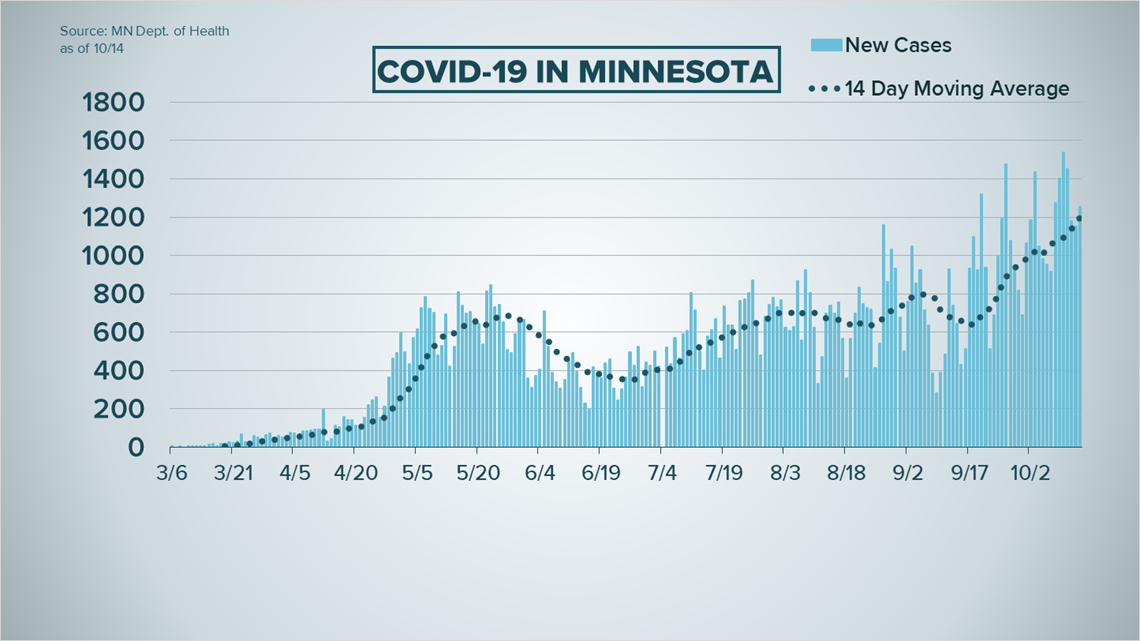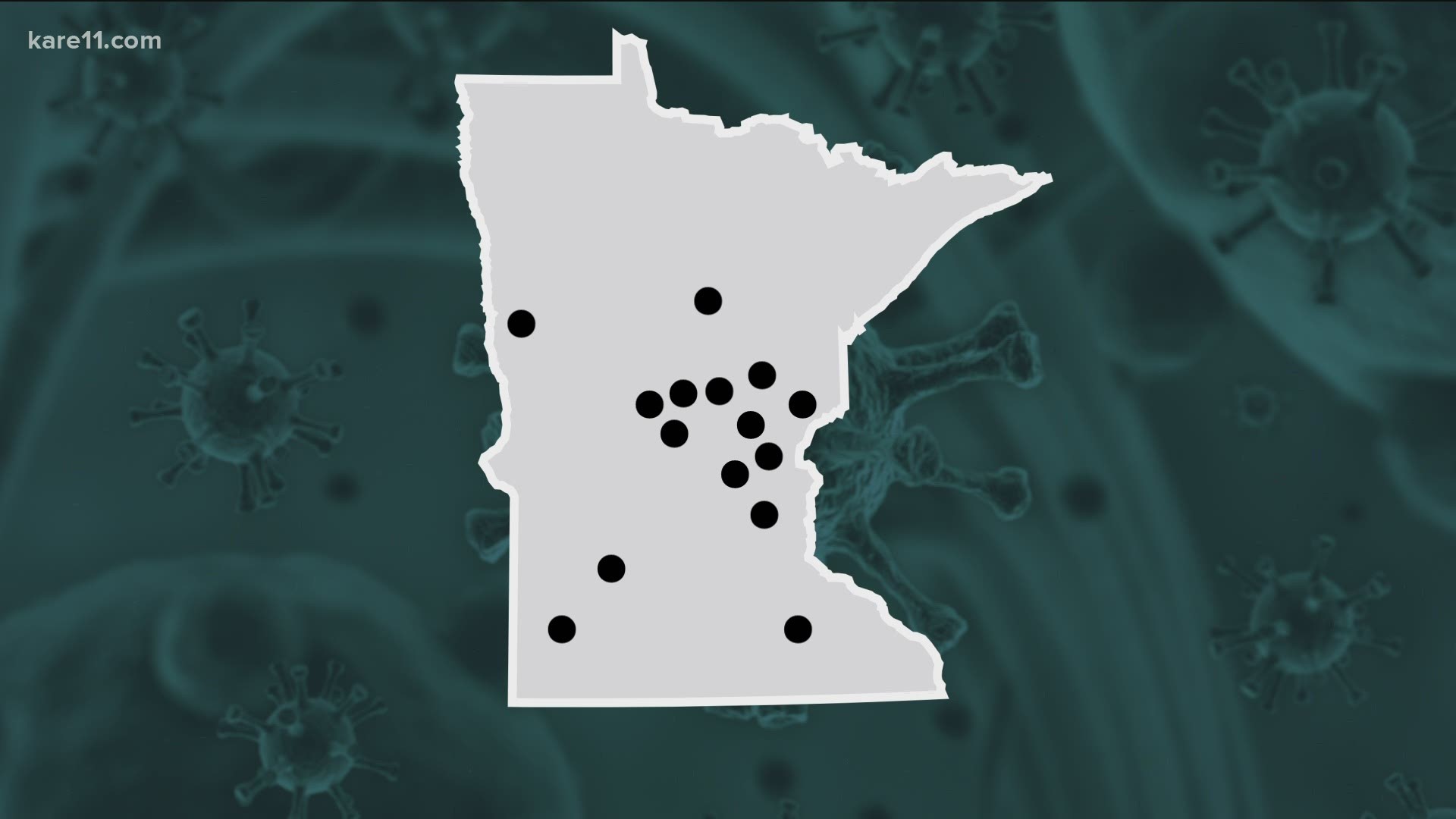ST PAUL, Minn. — Wednesday Oct. 14
- MDH reports 29 deaths, most since June 5
- Judge blocks Evers' order limiting bar and restaurant capacity
- Gov. Tim Walz announces more saliva testing sites going up this week
- MDH says testing capacity will double, from 30,000 to 60,000 per day
- Governor says the upper Midwest is now a COVID "hot spot"
- Minnesota hits sixth day in a row with more than 1,000 new COVID-19 cases
New numbers released Wednesday by the Minnesota Department of Health (MDH) reflect the highest single-day number of COVID-19 deaths in more than four months.
MDH reports that 29 people died of coronavirus in the last 24-hour reporting period, bringing Minnesota's total number of fatalities to 2,180 since the onset of the pandemic. On June 5, health officials reported 33 deaths caused by the virus.
Wednesday's numbers are a bit inflated today due to some new reporting procedures.
Starting Wednesday, state health officials are adding COVID deaths and new cases that were confirmed through antigen testing to their daily reports.
Wednesday's report includes six deaths that were confirmed through antigen testing and those cases back as far as September 1st.
State infectious disease director Kris Ehressman says MDH was waiting on guidance from health leaders before adding these cases to their daily reports.
“There’s a little bit of catch up with the numbers for today and then from this point on they will be real time,” Ehressman says.
For the seventh straight day, the number of new COVID cases has topped the 1,000 mark, with MDH recording 1,214 confirmed cases and 40 additional probable cases based on the results of 12,718 tests processed in private and state labs.


Total hospitalizations due to the virus are up to 8,585 since the pandemic began, with 2,346 of those cases requiring care in the ICU.
State health officials say 103,830 people who at one time tested positive for the coronavirus have recovered to the point they no longer require isolation.
Those between the ages of 20 and 24 remain Minnesota's largest group of cases by a significant margin, accounting for 15,162 cases and a single fatality. People between 25 and 29 make up 11,326 cases and three deaths, while those 15 to 19 comprise 10,810 cases and no deaths.
The state's largest grouping of deaths involves Minnesotans ages 85 to 89, who account for 375 deaths in just 1,558 diagnosed cases. That means 24% of people in that age group who are diagnosed with COVID-19 die from it.
Hennepin County reports the most COVID activity with 30,888 cases and 959 deaths, followed by Ramsey County with 12,635 cases and 337 deaths. Dakota County reports 8,731 cases and 133 fatalities.
Cook County in northeastern Minnesota reports the least COVID activity with eight confirmed cases, followed by Kittson County with just 18.
Tuesday, Oct. 13
2 p.m.
For the first time in months, Minnesota Gov. Tim Walz joined state health officials for their regular briefing call on COVID-19 Tuesday afternoon.
Walz highlighted the high rate of community spread in Minnesota, calling the upper Midwest a "hot spot" for coronavirus spread.
Once that happens, Walz said, the bad outcomes like hospitalizations and deaths begin to rise due to sheer numbers.
"We are certainly in a better place than our surrounding neighbors but that can change very quickly," Walz said.
The governor said that state leaders "have learned over seven months some of the things we can and cannot do that make a difference.”
One of the keys, Walz said, is testing and contact tracing to make sure that those carrying the virus, including those who are asymptomatic, can stay home and not infect others. Delays in testing and test results, the governor said, exacerbate that problem.
On Tuesday's call, Walz announced another step toward increasing that testing capacity and the speed with which people can get results back. He said two more saliva testing centers will open in Minnesota this week.
"It's not about anything other than breaking the transmission of this virus," he said. "States are getting this under control and Minnesota has done a really nice job of staying relatively stable, but ... you can go from stable and in a good position to building emergency hospitals on your fairgrounds like they did in Wisconsin."
Duluth already has the state's first large saliva testing site, opened Sept. 23 at the Duluth Entertainment Convention Center.
On Wednesday, the second semi-permanent saliva testing site opens at the Winona Mall. On Saturday, the third site will open in Moorhead at the former Thomas Edison High School. The next site after that will be in Brooklyn Park, opening Tuesday, Oct. 20 in the Starlite Center.
You can schedule testing appointments from the list of locations as they continue to open, online.
“Ensuring our community has accessible health services is a top priority in Brooklyn Park right now,” said Mayor Jeffrey Lunde in a press release. “Thank you to the state and the county for making this COVID-19 testing site possible so we can ensure our residents and all Minnesotans stay safe.”
According to a release, these tests will be processed in Minnesota at the new Infinity Biologix (IBX) COVID saliva lab in Oakdale, which will open next week.
Later this month, two additional sites in greater Minnesota and four more in the metro area will be finalized.
"Cases are growing faster than testing is," said Minnesota Department of Health (MDH) Assistant Commissioner Dan Huff. "That is not good."
Huff said that the newest saliva testing lab will be able to process 30,000 tests per day, which would quickly bring Minnesota's capacity to 60,000 per day.
“I remember when 5,000 tests a day would seem like a high bar to reach,” Walz said. “COVID’s taken a lot from us but we’ve learned a lot.”
Huff said that the centers will bill insurance if the person getting a test has it, but "no bill will go to you."
"If you are uninsured or underinsured you will not receive a bill," he promised.
Duluth Mayor Emily Larson gave an update about the Duluth testing center, which has been open for about three weeks. Larson said her husband had to have two negative COVID-19 tests before being able to visit his father.
"We have had a hard time getting access to tests in other ways," she said.
Larson said her husband scheduled a test Friday and got his results Sunday morning.
"It's that kind of access that is game-changing for people," she said.
Larson said that being able to get a test easily helps people to have more confidence navigating the pandemic.
"We are all sacrificing in a big way and part of the frustration, I think, has been that we're making sacrifices and not even having access to the test to find out if we have it or not," she said.
Brooklyn Park Mayor Jeffrey Lunde said that with 20% of their population born somewhere other than the U.S., the city is launching a mobile health care initiative to take resources directly to people who struggle with transportation issues. He said that saliva testing will also help to accomplish this goal.
"Our residents form the backbone, the invisible backbone of the health care system. They're the people working at hospitals, they're the people helping to serve the rest of us," Lunde said. "And so that access to testing is critical so that we don't have people spreading it, so that we're all safe when we're being tested."
Lunde said that when he speaks with residents, he finds that they don't care about a "Republican solution" or "Democratic solution." They just want a solution.
"People just want to be safe, they just want to survive this, and hopefully they want things at some point to get back to normal," he said.
While Wisconsin has recently dialed back, putting renewed restrictions on indoor gatherings, Gov. Walz said Minnesota isn't necessarily headed that way.
“One of the things we’ve learned over the seven months is to be more granular, to use the scalpel when we can," he said.
Walz said if Minnesota enacts any new restrictions, they would be "industry to industry" and more targeted. He pointed out that weddings and funerals are a large source of recent COVID spread.
“I think it would be dependent upon where the spread is coming from," Walz said, adding that people tend to get frustrated with wide-reaching restrictions.
11 a.m.
Minnesota has recorded its sixth consecutive day of 1,000-plus new COVID-19 cases, a dubious mark that has state health officials concerned.
On Tuesday the Minnesota Department of Health (MDH) reported 1,150 confirmed cases in the past 24-hour reporting period, based on results from 19,444 tests processed in private labs. That brings Minnesota's coronavirus case total to 114,574 since the onset of the pandemic.
Seven more people have died of COVID-19, bringing fatalities to 2,151. Of those deaths 1,524, or 71%, have occurred in long-term care or assisted living settings.
MDH says 8,500 people have been hospitalized for treatment of the coronavirus, with 2,328 of them requiring care in the ICU. As of Tuesday 102,624 people who at one time tested positive for the virus have improved to the point they no longer require isolation.
Those ages 20 to 24 make up the largest group of Minnesota's COVID cases with 15,043 and one death, while people between 25 and 29 account for 11,200 cases and three fatalities. The age group from 15 to 19 comprises 10,711 cases and no deaths.
Minnesota's largest grouping of fatalities involves those between 85 and 89, who account for 369 deaths in just 1,538 confirmed cases. That means 24% of people in that demographic who were diagnosed with COVID died from it.
Hennepin County has the most COVID activity of any county in the state, reporting 30,698 cases and 955 deaths, while Ramsey County has 12,532 confirmed cases and 335 fatalities. Dakota County reports 8,673 cases and 132 deaths.
Cook County has the least COVID activity of any county in the state with nine cases, while Kittson County reports 17 cases.
KARE 11’s coverage of the coronavirus is rooted in Facts, not Fear. Visit kare11.com/coronavirus for comprehensive coverage, find out what you need to know about the Midwest specifically, learn more about the symptoms, and see what businesses are open as the state slowly lifts restrictions. Have a question? Text it to us at 763-797-7215. And get the latest coronavirus updates sent right to your inbox every morning. Subscribe to the KARE 11 Sunrise newsletter here. Help local families in need: www.kare11.com/give11.
The state of Minnesota has set up a data portal online at mn.gov/covid19.

